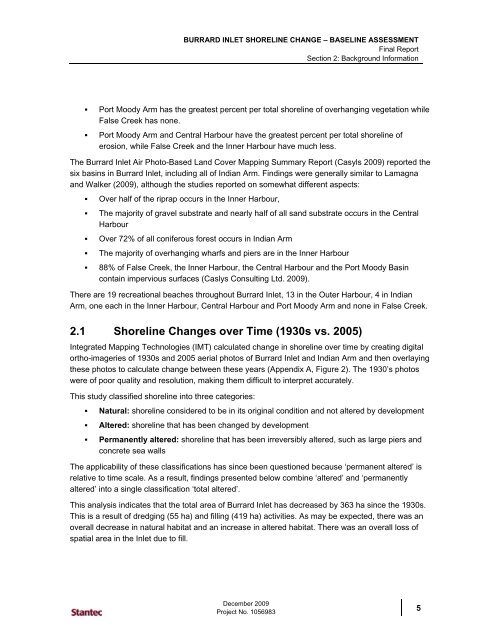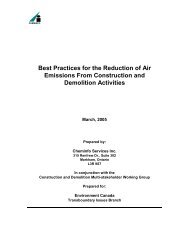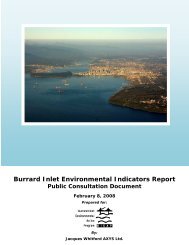BURRARD INLET SHORELINE CHANGE – BASELINE ASSESSMENT
BURRARD INLET SHORELINE CHANGE – BASELINE ASSESSMENT
BURRARD INLET SHORELINE CHANGE – BASELINE ASSESSMENT
Create successful ePaper yourself
Turn your PDF publications into a flip-book with our unique Google optimized e-Paper software.
<strong>BURRARD</strong> <strong>INLET</strong> <strong>SHORELINE</strong> <strong>CHANGE</strong> <strong>–</strong> <strong>BASELINE</strong> <strong>ASSESSMENT</strong><br />
Final Report<br />
Section 2: Background Information<br />
Port Moody Arm has the greatest percent per total shoreline of overhanging vegetation while<br />
False Creek has none.<br />
Port Moody Arm and Central Harbour have the greatest percent per total shoreline of<br />
erosion, while False Creek and the Inner Harbour have much less.<br />
The Burrard Inlet Air Photo-Based Land Cover Mapping Summary Report (Casyls 2009) reported the<br />
six basins in Burrard Inlet, including all of Indian Arm. Findings were generally similar to Lamagna<br />
and Walker (2009), although the studies reported on somewhat different aspects:<br />
Over half of the riprap occurs in the Inner Harbour,<br />
The majority of gravel substrate and nearly half of all sand substrate occurs in the Central<br />
Harbour<br />
Over 72% of all coniferous forest occurs in Indian Arm<br />
The majority of overhanging wharfs and piers are in the Inner Harbour<br />
88% of False Creek, the Inner Harbour, the Central Harbour and the Port Moody Basin<br />
contain impervious surfaces (Caslys Consulting Ltd. 2009).<br />
There are 19 recreational beaches throughout Burrard Inlet, 13 in the Outer Harbour, 4 in Indian<br />
Arm, one each in the Inner Harbour, Central Harbour and Port Moody Arm and none in False Creek.<br />
2.1 Shoreline Changes over Time (1930s vs. 2005)<br />
Integrated Mapping Technologies (IMT) calculated change in shoreline over time by creating digital<br />
ortho-imageries of 1930s and 2005 aerial photos of Burrard Inlet and Indian Arm and then overlaying<br />
these photos to calculate change between these years (Appendix A, Figure 2). The 1930’s photos<br />
were of poor quality and resolution, making them difficult to interpret accurately.<br />
This study classified shoreline into three categories:<br />
Natural: shoreline considered to be in its original condition and not altered by development<br />
Altered: shoreline that has been changed by development<br />
Permanently altered: shoreline that has been irreversibly altered, such as large piers and<br />
concrete sea walls<br />
The applicability of these classifications has since been questioned because ‘permanent altered’ is<br />
relative to time scale. As a result, findings presented below combine ‘altered’ and ‘permanently<br />
altered’ into a single classification ‘total altered’.<br />
This analysis indicates that the total area of Burrard Inlet has decreased by 363 ha since the 1930s.<br />
This is a result of dredging (55 ha) and filling (419 ha) activities. As may be expected, there was an<br />
overall decrease in natural habitat and an increase in altered habitat. There was an overall loss of<br />
spatial area in the Inlet due to fill.<br />
December 2009<br />
Project No. 1056983<br />
5
















